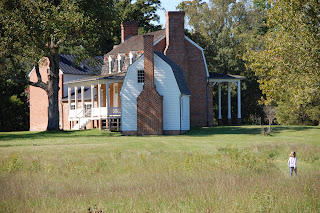We made up for lost time today, visiting three parks
and making a run to Costco! The girls are three junior ranger badges richer, and Stan and I have a new appreciation for Virginia and its rich--and often tragic--history. Our stops covered the colonial, revolutionary and civil war eras. Needless to say, we're all a little tired tonight.
George Washington's birthplace was fascinating; a tobacco plantation along the tidal estuary of Pope's Creek off of the Potomac River, it features an outline of the home in which our country's first president was born. Also on the land is a house in the colonial era style, erected in 1930 as a memorial to the Washington family. It was built before the foundations of the family's actual home (which burned to the ground in 1779) were discovered in 1936...and the lines of the two are very different. Still, we enjoyed the memorial home as it represented the lifestyle of many well-to-do farmers in Colonial Virginia. And it contains a couple of pieces recovered from the ruins of the Washington home...an intact wine bottle and a side table. It's interesting to think of the Washington family as they welcomed their newest son, George; it's doubtful they could have imagined a world in which the colonies fought for their independence from the British crown, or that their infant son would lead that fight and become the new nation's first president.
One of the men in George Washington's political circles was Thomas Stone, a lawyer from Maryland (he lived just a few miles across the Potomac from Washington's birthplace, although the limited number of accessible roads made the distance much greater). Stone was one of Maryland's four signers of the Declaration of Independence, and the Thomas Stone National Historical Site features his estate, Haberdeventure, which remained in the family for nearly 160 years. We were reminded by the site's rangers that each and every signer of the Declaration was in fact publicly admitting to treason and therefore placing their lives and those of their families in tremendous danger. Stone's home was never directly attacked, but the possibility of such was a constant threat. Perhaps due in part to that stress, Stone died just a few years later, at age 44, and four months after his wife (she'd suffered from mercury poisoning for 11 years). Stan and I were struck by how much influence and life-altering action he'd taken in his short life; in addition to his signing of the Declaration, he helped draft the Articles of Confederation, which governed the colonies from 1776-1789, when the Constitution was adopted.
The irony that both the Washington and Stone families owned slaves was not lost on us, especially in light of our third stop: the Fredericksburg Battlefield National Military Park. The state of Virginia saw more than 40% of the Civil War's action, and its town of Frederickburg was one of the largest casualties. Destroyed not just by bullets and bombs, it was looted and pillaged by Union troops who won an early skirmish, and who burned the town's pianos and treasured books as easily as firewood. It's said that the inhabitants left everything in their evacuation, and the Union troops left nothing. Hardened in their resolve by such acts of wanton destruction against civilians, the Confederates fought back with a vengeance. In four area battles over the course of 18 months, more than 105,000 men were injured or killed. In the Fredericksburg fighting on December 13, 1862, following the town's pillaging, 1,000 Union soldiers died every hour. Upon hearing of the losses, Lincoln was devastated and said, "If there is a hell, I am surely in it."
Towns such as Frederickburg, which were caught in the crosshairs of battle, took more than 100 years to regain their pre-Civil War population. The crushing of civilian morale and the southern lifestyle (especially after the Emancipation Proclamation) are what ultimately brought the Confederacy to the breaking point. Visiting the town of Fredericksburg today was a study in mixed sympathies: seeing museum exhibits about its destruction, and walking by bullet-ridden buildings...which cast a literal shadow onto the town's still-standing auction block, from which slaves were sold to the highest bidder. Chilling. We're relieved that the girls' focus on the deftly-created junior ranger books, combined with their age and innocence, protects them from the harsher realities that Stan and I, as adults with a basic knowledge of our country's history, can't help but absorb.
 |
| Kendall calling to one of the pigs on the Washington property |
 |
| A wine bottle excavated from the burned remains of the Washington home |
 |
| View of Pope's Creek from the Washington property. We learned that their front door would have faced the water, not the road, as their business was conducted by water. |
 |
| Thomas Stone's Haberdeventure (with the Stevens girls burning off some energy on the path leading to it) |
 |
| one-and-a-half junior rangers? |
 |
| Fredericksburg's auction block in the foreground, surrounded by the trappings of a modern community |






No comments:
Post a Comment